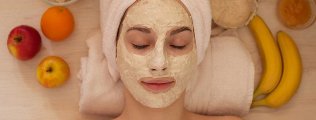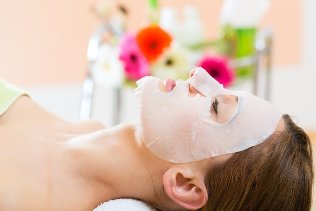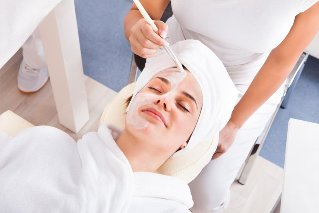
The cosmetics industry develops tons of masks, offering them to both professional salons and home use. However, handmade face masks made from natural ingredients will always be preferred from factory-made options.
After 25 years, girls should start facial care and not only wash with clean water, but also nourish themselves with various masks. Otherwise, inadequate care manifests itself in early mimic wrinkles and noticeable deterioration of skin condition.
Are there any face masks?
Typically, facial masks are categorized according to their effect. There are mask types:
- Nourishing, moisturizing, toning and cleansing - they are designed for permanent skin care and maintenance;
- Anti-inflammatory, whitening, anti-couperose - this group of masks successfully fights obvious skin imperfections;
- Anti-aging, lifting masks - belong to the anti-aging group and help tighten facial skin.
How to determine your skin type
Before choosing a face mask, you need to determine your skin type. In classical cosmetology it is common to distinguish skin type:
- Thick,
- dry,
- normal,
- Combined.
Since different skin needs are drastically different, a handmade facial mask should be selected depending on what skin type you are.
This is usually not a problem, as girls tend to pay close attention to their appearance and skin type can even be determined by looking at themselves in a mirror. However, sometimes difficulties arise. Therefore, to accurately determine your skin type at home, wash your face with ordinary neutral soap and do not use any product on it.
After about an hour and a half, soak a well-absorbent paper towel on your face. Take a good look at the napkin and evaluate the quality of oily skin:- If there are traces of fat on the surface of the napkin, it means that the skin is completely exposed and you have oily skin type.
- If there are no traces left on the napkin, but the skin does not crumble and does not feel tight, your skin type is normal.
- If there are no greasy marks on the napkin, but you clearly feel tightness, your skin is of the dry type.
- If the forehead, nose and chin in the center of the handkerchief are imprinted with bold marks, and the skin on the cheeks and temples is left with no marks (dry or normal), then such an uneven distribution of fat indicates a combination or mixed skin type.
Nourishing facial masks at home

Nourishing masks are essential for skin nutrients, vitamins and micronutrients.
Recipe # 1. Nourishing mask for oily skin (honey)
A simple composition made from 2 teaspoons of honey, 20 drops of lemon juice and 1 tablespoon of low-fat sour cream is ideal for oily skin. Mix all the ingredients in a bowl until smooth, apply the resulting mixture on the face. Keep it for 20 minutes to half an hour, then rinse with warm water.
The mask nourishes the skin, gives it an even color, radiance and beauty.
Recipe # 2. Nourishing mask for dry skin
Use the following ingredients to nourish dry skin:
- 1 egg heart,
- 2 teaspoons milk
- 1 half tablespoon thin oat flakes.
Pour oatmeal with very warm milk, simmer slightly (10-15 minutes). Beat the egg yolks with a fork and mix the flakes. Apply the mass on your face and leave on for 20 minutes.
This soothing mask penetrates deep into the pores, nourishes dry skin, relieves the feeling of tightness and flaking, leaves it soft and velvety.
Recipe # 3. Nourishing mask for normal skin
It is a big misconception that normal facial skin does not need nourishment and care, saturation with vitamins. A nourishing mask for normal skin, based on grapes, gently and carefully cares for the skin, soothes it.
Grind 6-7 grapes of any white variety (or black as an extreme remedy), remove all seeds and skin, combine the grape mass with 1 tablespoon of sour cream. Apply the mass on your face, leave on for 20-30 minutes, then rinse with warm water. The mask is so nutritious that even skin irritations can heal.Moisturizing masks at home
Natural moisturizing face masks moisturize the skin. Most often, hydration is necessary in summer and spring, when under the influence of ultraviolet radiation and ambient temperature, part of the moisture is lost from the surface layers of the skin. Even mild dehydration can lead to decreased skin elasticity, dirt and wrinkles.
Recipe # 4. Moisturizing masks for oily skin
The following recipe will help you moisturize oily skin. Beat 1 egg white and mix with 20 ml of liquid honey until smooth. Add 1 tablespoon chopped oatmeal. Apply the mask on your face, leave on for 20 minutes. Rinse first with warm water, then rinse face with cold water. Flakes can be replaced with potatoes or starch to help tighten pores and nourish the skin.
Recipe # 5. Moisturizing masks for dry skin
Dry is perfectly separated by a curd mask.
Dry skin especially needs hydration, not only in summer and spring, but generally at any time of the year. Mix about 30 g of plain fat cottage cheese with 2 tablespoons of milk, warm to body temperature. Bring the mass to a uniform consistency, without lumps. Apply the resulting mask on the skin for 15 minutes. Rinse with warm water.
Recipe # 6. Moisturizing masks for normal skin
Use a grapefruit mask to moisturize normal skin. To do this, mix the sliced pulp of two slices of grapefruit with 1 egg yolk. Apply the mask on the skin for 15 minutes. Then rinse with warm water.
Homemade face mask softening and cleansing
Cleansing and tonic masks generally enhance the beneficial effect on the skin, activate the subcutaneous circulation and cleanse the facial pores from oily secretions, giving it a youthful look.
Recipe # 7. Tonic mask for oily skin
Oily skin is perfectly softened by a white clay mask. To prepare it, dissolve 2 tablespoons of white clay in cold boiled water, add 1 egg white, 3-4 drops of lemon juice and 5 ml of honey. The resulting homogeneous mass should consistently resemble sour cream. Apply the mask on your face and wait until it dries completely. Rinse the clay mask with warm water as soon as it is completely dry.
Recipe # 8. Cleansing Mask for Dry Skin
Dry skin is visibly refined and cleansed by the action of white clay. To prepare the mask at home, take 1 tablespoon of white clay, 2 times more milk and 5 ml of honey. Mix until smooth and apply on face. After 10-15 minutes, rinse the mask and finally, after cleansing, use a moisturizer.
Recipe # 9. Tonic mask for normal skin
Normal skin quickly regains freshness and density with lemon peel facial mask. Mix 1 heart and 20 ml of low-fat sour cream, add 1 lemon finely grated celery. Keep the mask on your face for no more than 30 minutes.
Homemade whitening face masks
Many girls dream of getting rid of wrinkles and whitening their face altogether. Facial masks at home will help brighten age spots, even age spots.
Recipe # 10. Cucumber whitening mask is known for its good effect. Finely chop a medium-sized cucumber (no seeds) and mix with your daily nourishing cream or sour cream. Apply the mass on the face for 20 minutes. Rinse with warm water.
Recipe # 11. The next whitening face mask turned out to be quite liquid. At home, mix liquid honey and lemon juice in equal parts by volume. The resulting mass of impregnated gas wipes, which are then placed on your face. Leave on for 15 minutes, then remove the tissues and gently rinse your face with water.
Anti-aging home face masks
Over time, the skin begins to age - this is an inevitable process. But the first problem wrinkles should not be lost to the heart, but rather consider a rejuvenating procedure with regular skin care. Regular use of anti-aging collagen masks allows you to delay new age-related changes on the facial skin and get rid of existing small wrinkles.
Recipe # 12. Aloe Vera Rejuvenating Facial Mask is very popular at home. Combine a tablespoon of the juice of this plant with the same amount of nourishing face cream and premium vegetable oil (preferably olive oil). Mix and apply the mask slightly warm, keep it on the face for 10 minutes.
Recipe # 13. In summer, you can make a mask from fresh plant leaves. Grind the leaves with ginger and mix the honey in equal parts. If the mixture is too thick, like a gelatinous mixture, dilute it slightly with water. Keep this saw on your face for at least 15 minutes. Remove it first with a damp swab, then rinse your face with cool water. Neither botulinum toxin is required.
Masks with a lifting effect on the face at home
Fighting sagging skin requires the attention of women over the age of 30. Therefore, when the skin begins to fade, you need to arm yourself with time-tested remedies that will help straighten the top layer of the epidermis.
Recipe # 14. This anti-aging mask for this vitamin is made at home from pharmacy ingredients.
Composition:
- 1 round spoon of pink clay,
- 1 ampoule of vitamin A
- Boiling 30 ml flavored green tea.

Gently mix the dry clay with the tea and stir continuously to a uniform texture. Add vitamin A and apply the whole mixture on the skin. The mask lasts 25 minutes. Regular use of this recipe restores skin density and health.
Rinse this mask with plenty of cool water.
Recipe # 15. Natural and effective lifting can be observed in egg white. Whisk one egg white into a stiff foam and mix with two teaspoons of soaked oatmeal. The time of application of the mask on the skin is 15 minutes.
According to girls, there is a lifting effect: the skin tightens.
How to properly apply a face mask at home
Before applying any mask, you should clean your face to remove gentle makeup from decorative cosmetics. The cooling gel usually performs the makeup removal procedure, but you can use an extra peel.
Pre-exfoliation of dead cells is desirable for penetration into all facial skin, which creates a mask, this ensures its greatest effectiveness. The scrub can be used at home, for example, according to any recipe for coffee scrub.
Follow the general rules of home cosmetics when using masks:
- The mask application procedure cannot be performed "while running". Put on all the household chores and spend half an hour on yourself.
- Any effective handmade face mask should be prepared (mixed) before use. The remaining mass cannot be stored.
- All components of the mask should be of good quality, while the ingredients such as sour cream, fruit, kefir, etc. Sh. , Must be new.
- Before applying the mask, the face should be cleansed as usual. Owners of oily and combination skin will probably need a pre-exfoliating scrub as well. After cleansing the skin, open its pores as much as possible, you can blow on the bath or make a warm, wet compress. This will allow all the ingredients to be absorbed as much as possible and have the best effect.
- To avoid hair, attach it to a bun and place something on it.
- The mask should be applied consistently with clean hands, a brush, gauze or cotton swab.
- Most masks should be applied not only on the face, but also on the neck and décolleté. The exception will be drying masks for oily skin, as the skin in the décolleté area is much drier.
- Apply the homemade mask along the massage lines, with movements from the middle of the face to the temples. The exception is the skin directly around the eyes; You do not need a mask on it.
- Rinse the mask with clean water. It is better not to take from the tap, but rather to prepare a jug of boiled water in advance, cooled to body temperature.
- Wash the mask, you do not need a face towel, gently wipe off excess moisture with a clean towel. Apply a cream suitable for your skin type on a damp face.
- Do not expect an immediate effect from the very first procedure. Homemade facial masks should be repeated regularly at intervals of 1-3 times a week. The duration of the course should be at least 3 weeks.
Precautions when using home masks
For girls prone to allergies, a test inside the wrist or elbow should be performed before using a home-made mask. If signs of an allergic reaction appear, take an antihistamine and do not use this product.














































































